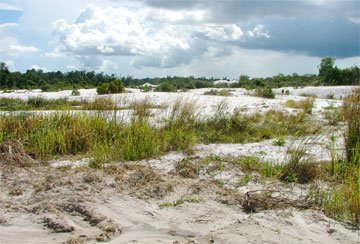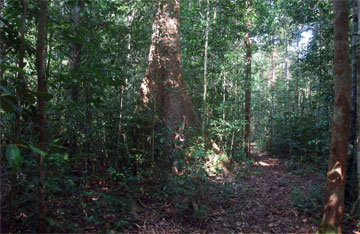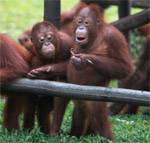Stripped of vegetation, Borneo becomes a near-lifeless wasteland.
The lush green rainforests of Central Kalimantan (Indonesian Borneo) grow on a desert. The illusion of organic richness and bounty is nowhere stronger than in these coastal jungles and mangroves, swamps and heath forests. The soaring trees and dizzying diversity of flora and fauna suggest that there are reserves of energy and life stored somewhere in the land, and all the living organisms draw on this infinite reserve. Nothing could be further from the truth.
Borneo, the world’s third largest island, has exemplary rainforest soils: shallow and nutrient poor. The abundance of rain in these ancient ecosystems has leached the soil for millions of years. The world over, topsoil in tropical rainforests extends no deeper than 20 cm, often 10 cm, and contains almost all the available supple of nitrogen, phosphorous and potassium. These essential minerals are taken up by the growing vegetation as soon as they become available, and become locked into the living biomass. Once the leaves fall or an entire plant comes down to the ground, the vegetative matter is rapidly broken down by animal, fungal and microbial decomposers, and the nutrients once more enter the soil, to be rapidly utilized. It is a deeply interconnected and fragile cycle.
  Photos by Janie Dubman |
Southern Kalimantan Tengah (Central Indonesian Borneo), where the Orangutan Foundation International, a group working to protect and rehabilitate endangered orangutans, does most of its work, has soils that are not just poor, but also sandy. This is due partly to the fact that the area is coastal, and partly to geological influences. In its pristine rainforest state, this sand, covered with topsoil, supports thousands of tree species; hundreds of these produce fruit which feeds Borneo’s fourteen primate species, birds, rodents, insects, sun bears and wild boars. When cleared and carefully cultivated, some vegetable crops can be grown, as well as peanuts and fruit including bananas, pineapples, papayas, citruses and jackfruit. Previously, as recently as 20 years ago, local people cultivated dry rice paddies and grew all their own produce.
Now, much of this valuable but fragile land is undergoing fundamental changes. Removing forest for human habitation and use is disrupting the nutrient cycle, and the consequences vary. Robbing the soil of its natural leaf litter means frequent and thorough fertilization is necessary to grow produce on the depauperate soil, and even so, not all areas are workable. When clearcut for housing and urbanization, the ground cover disappears, and only the sand remains to reflect the heat. The most staggering changes, however, are caused by large scale, industrial operations. Logging, whether legal or illegal, removes the majority of standing organic matter and opens the soil to rapid desiccation, erosion and nutrient loss. Very few species can grow on this soil, and a long time must pass for stray organic matter to accumulate and create a topsoil that will nurture seedlings. Mining does the equivalent of taking a scouring sponge and scraping the landscape. Everything from the buttress tress down to the moss is slashed and burned. Mining sites in the vicinity of Tanjung Puting National Park, some of which hug the park border, are eerie moonscapes with mounds and valleys of bleached sand, silent and shimmering in the heat. The national park, often less than two meters away, testifies to what the ravaged land used to be.
The apparent might of a rainforest can be deceiving, and the delicate balance of life in it is truly all-encompassing. If we want these green jewels to keep decorating Earth’s equator, we must be able to see past the trees; not only the forest, but the treasures beneath it, too.
Earlier post by Janie Dubman
Empowering people by saving orangutans
(06/06/2010) The lives of over 200 people have been linked to orangutans for 40 years. The people are biologists, firefighters, carpenters, veterinarians, drivers, artists and nurses. The orangutans are the only great apes in Asia, highly intelligent and highly endangered. The location is Borneo, Indonesia, and the mission is the save the orangutans from extinction. The leader is Dr. Birute Mary Galdikas.
Related articles
Turning wasteland into rainforest
(07/31/2009) The highly touted reforestation project launched by orangutan conservationist Willie Smits in Indonesian Borneo is detailed in this week’s issue of Science.
Rehabilitation not enough to solve orangutan crisis in Indonesia

(08/20/2009) A baby orangutan ambles across the grass at the Borneo Orangutan Survival Foundation’s Nyaru Menteng rehabilitation center in Central Kalimantan, in the heart of Indonesian Borneo. The ape pauses, picks up a stick and makes his way over to a plastic log, lined with small holes. Breaking the stick in two, he pokes one end into a hole in an effort to extract honey that has been deposited by a conservation worker. His expression shows the tool’s use has been fruitful. But he is not alone. To his right another orangutan has turned half a coconut shell into a helmet, two others wrestle on the lawn, and another youngster scales a papaya tree. There are dozens of orangutans, all of which are about the same age. Just outside the compound, dozens of younger orangutans are getting climbing lessons from the Borneo Orangutan Survival Foundation (BOS) staff, while still younger orangutans are being fed milk from bottles in a nearby nursery. Still more orangutans—teenagers and adults—can be found on “Orangutan Island” beyond the center’s main grounds. Meanwhile several recently wild orangutans sit in cages. This is a waiting game. BOS hopes to eventually release all of these orangutans back into their natural habitat—the majestic rainforests and swampy peatlands of Central Kalimantan, on the island of Borneo. But for many, this is a fate that may never be realized.
(05/24/2006) A look at conservation efforts in Kalimantan, on the island of Borneo. I’m in Tanjung Puting National Park in southern Kalimantan on the island of Borneo. At 400,000 hectares (988,000 acres) Tanjung Puting is the largest protected expanse of coastal tropical heath and peat swamp forest in southeast Asia. It’s also one of the biggest remaining habitats for the critically endangered orangutan, the population of which has been great diminished in recent years due to habitat destruction and poaching. And orangutans have become the focus of a much wider effort to save Borneo’s natural environment. We are headed to Campy Leakey, named for the renowned Kenyan paleontologist Louis Leakey. Here lies the center of the Orangutan Research conservation Project. Established by Birute Mary Galdikas, a preeminent primatologist and founder of the Orangutan Foundation International (OFI), the project seeks to support the conservation and understanding of the orangutan and its rain forest habitat while rehabilitating ex-captive individuals. The Orangutan Research conservation Project is the public face of orangutan conservation in this part of Kalimantan, the Indonesia-controlled part of Borneo. Borneo, the third largest island in the world, was once home to some of the world’s most majestic, and forbidding forests. With swampy coastal areas fringed by mangrove forests and a mountainous interior, much of the terrain was virtually impassable and unexplored. Headhunters ruled the remote parts of the island until a century ago.